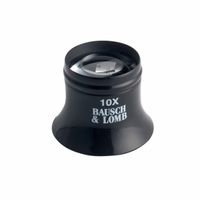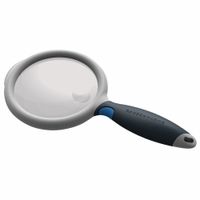Call +(254) 703 030 000 / 751 483 999 / 721 704 777
- Home
- Machining
- Precision Measuring Tools
- Magnification Instruments
.....Read More
Frequently Asked Questions
What is the difference between a magnifier and a loupe?
A magnifier and a loupe are both optical tools used to enlarge the appearance of objects, but they differ in design, usage, and application.
A magnifier, commonly known as a magnifying glass, typically consists of a convex lens mounted in a frame with a handle. It is designed for general use, allowing users to hold it at varying distances from the object to achieve the desired magnification. Magnifiers are versatile and used for reading small print, examining maps, or inspecting objects in everyday situations. They usually offer lower magnification levels, typically ranging from 2x to 10x.
A loupe, on the other hand, is a small, compact magnification device often used by professionals such as jewelers, watchmakers, and photographers. It is designed to be held close to the eye, providing a hands-free experience. Loupes offer higher magnification levels, usually between 10x and 30x, and are used for detailed inspection of small objects, such as gemstones, watch components, or photographic negatives. They often have a more complex lens system, sometimes incorporating multiple lenses to reduce distortion and improve clarity.
In summary, the main differences between a magnifier and a loupe lie in their design, magnification power, and intended use. Magnifiers are larger, handheld tools for general purposes with lower magnification, while loupes are compact, high-magnification devices used for detailed examination in specialized fields.
How do you choose the right magnification level for a magnifier?
To choose the right magnification level for a magnifier, consider the following factors:
1. **Purpose**: Determine the task you need the magnifier for. Reading small print may require lower magnification (2x-3x), while detailed work like inspecting jewelry or electronics might need higher magnification (5x-10x).
2. **Field of View**: Higher magnification reduces the field of view. If you need to see a larger area, opt for lower magnification. For detailed inspection of small areas, higher magnification is suitable.
3. **Working Distance**: Higher magnification often means a shorter working distance between the lens and the object. Ensure the magnification level allows comfortable viewing without straining your eyes or neck.
4. **Image Clarity**: Higher magnification can lead to image distortion or reduced clarity. Choose a magnification level that provides a clear image without significant distortion.
5. **Lighting Conditions**: Consider the lighting where you’ll use the magnifier. Some magnifiers come with built-in lights to enhance visibility, especially at higher magnifications.
6. **Portability**: If you need a magnifier for on-the-go use, consider a compact, lower-magnification option. For stationary tasks, larger, higher-magnification models might be more appropriate.
7. **User Comfort**: Ensure the magnifier is comfortable to use for extended periods. Ergonomic designs and lightweight materials can enhance comfort.
8. **Trial and Error**: If possible, test different magnification levels to see which one suits your needs best. Personal preference plays a significant role in choosing the right magnification.
By considering these factors, you can select a magnification level that balances clarity, comfort, and functionality for your specific needs.
What are the best magnifiers for reading small text?
The best magnifiers for reading small text are those that offer clarity, ease of use, and portability. Here are some top options:
1. **Handheld Magnifiers**: These are versatile and come in various magnification levels, typically ranging from 2x to 10x. They are ideal for quick reading tasks and are portable. Look for models with built-in LED lights for better illumination.
2. **Stand Magnifiers**: These are perfect for prolonged reading sessions. They rest on the page, allowing hands-free use. They often come with higher magnification and are suitable for individuals with severe vision impairment.
3. **Fresnel Magnifiers**: These are lightweight, flat magnifiers that can be slipped into a book or pocket. They are less powerful but are convenient for casual use.
4. **Dome Magnifiers**: These are placed directly on the text and provide a clear, distortion-free view. They are easy to use and require no focusing, making them great for reading newspapers or maps.
5. **Electronic Magnifiers**: These devices offer adjustable magnification and contrast settings. They can display text on a screen, making them suitable for those with significant vision loss. Some models are portable, while others are designed for desktop use.
6. **Clip-on Magnifiers**: These attach to glasses and are useful for hands-free reading. They are ideal for those who need occasional magnification without carrying a separate device.
7. **Magnifying Glasses**: These are worn like regular glasses and provide a wide field of view. They are convenient for continuous use and are available in various magnification strengths.
When choosing a magnifier, consider the level of magnification needed, the size and weight of the device, and any additional features like lighting or digital display.
How do you use a magnifier with a measuring scale?
To use a magnifier with a measuring scale, follow these steps:
1. **Select the Right Magnifier**: Choose a magnifier with an integrated measuring scale, often called a loupe or scale magnifier. Ensure it has the appropriate magnification power and scale type (metric or imperial) for your needs.
2. **Prepare the Object**: Place the object you wish to measure on a stable, flat surface. Ensure it is well-lit to enhance visibility through the magnifier.
3. **Position the Magnifier**: Hold the magnifier above the object, aligning the scale with the area you want to measure. Some magnifiers have a stand or base for stability, which can be useful for precise measurements.
4. **Adjust the Focus**: If the magnifier has an adjustable focus, fine-tune it until the object and scale are in sharp focus. This ensures accurate reading and reduces eye strain.
5. **Read the Measurement**: Look through the magnifier and read the measurement where the object aligns with the scale. Ensure your eye is directly above the scale to avoid parallax error, which can distort the reading.
6. **Record the Measurement**: Note down the measurement for reference. If necessary, repeat the process to confirm accuracy.
7. **Care and Maintenance**: After use, clean the magnifier lens with a soft cloth to remove any dust or fingerprints. Store it in a protective case to prevent scratches.
By following these steps, you can effectively use a magnifier with a measuring scale for precise measurements in various applications, such as inspecting small parts, reading fine print, or conducting scientific research.
What are the common uses of magnifiers in various fields?
Magnifiers are versatile tools used across various fields for their ability to enlarge images and details, enhancing visibility and precision.
1. **Medicine and Healthcare**: In medical fields, magnifiers are crucial for surgeries and examinations. Surgeons use magnifying loupes to enhance precision during delicate procedures. Dermatologists and dentists also use magnifiers to closely examine skin conditions and oral health, respectively.
2. **Forensics**: Forensic experts use magnifiers to analyze evidence such as fingerprints, fibers, and other minute details at crime scenes. This helps in identifying crucial evidence that might be invisible to the naked eye.
3. **Jewelry and Watchmaking**: Jewelers and watchmakers rely on magnifiers to inspect gemstones for flaws and to assemble intricate watch components. This ensures quality and precision in their craftsmanship.
4. **Education and Research**: In educational settings, magnifiers are used in biology and geology to study specimens like insects, plants, and minerals. Researchers use them to observe fine details in various scientific studies.
5. **Electronics and Engineering**: Technicians and engineers use magnifiers to inspect and repair small electronic components and circuit boards, ensuring accuracy in assembly and maintenance.
6. **Art and Restoration**: Artists and conservators use magnifiers to create detailed artwork and to restore paintings and artifacts, ensuring that every detail is preserved or replicated accurately.
7. **Hobbies and Crafts**: Hobbyists involved in activities like model building, stamp collecting, and needlework use magnifiers to enhance their ability to work with small parts and intricate designs.
8. **Optometry**: Optometrists use magnifiers to examine patients' eyes, aiding in the diagnosis of vision problems and the fitting of corrective lenses.
9. **Reading and Accessibility**: Magnifiers assist individuals with visual impairments in reading and performing daily tasks, enhancing their quality of life by improving accessibility.
How do you clean and maintain a magnifying instrument?
To clean and maintain a magnifying instrument, follow these steps:
1. **Preparation**: Ensure the instrument is turned off and unplugged if it has electrical components. Gather cleaning materials such as a microfiber cloth, lens cleaning solution, compressed air, and cotton swabs.
2. **Dust Removal**: Use compressed air to gently blow away loose dust and debris from the surface and crevices of the instrument. Hold the can upright to avoid moisture release.
3. **Lens Cleaning**: Apply a few drops of lens cleaning solution to a microfiber cloth. Gently wipe the lens in a circular motion, starting from the center and moving outward. Avoid applying the solution directly to the lens to prevent liquid seepage into the instrument.
4. **Body Cleaning**: Dampen a microfiber cloth with water or a mild detergent solution. Wipe the body of the instrument to remove fingerprints and smudges. Avoid excessive moisture to prevent damage to electronic components.
5. **Detailing**: Use cotton swabs dipped in lens cleaning solution to clean hard-to-reach areas and edges. Ensure no fibers are left behind.
6. **Inspection**: Check for any signs of wear or damage, such as scratches on the lens or loose parts. Address any issues promptly to prevent further damage.
7. **Storage**: Store the instrument in a clean, dry place, preferably in a protective case or cover to prevent dust accumulation. Keep it away from direct sunlight and extreme temperatures.
8. **Regular Maintenance**: Schedule regular maintenance checks, especially for professional-grade instruments. Follow the manufacturer's guidelines for calibration and servicing.
By following these steps, you can ensure the longevity and optimal performance of your magnifying instrument.
What are the advantages of using a loupe over a standard magnifier?
A loupe offers several advantages over a standard magnifier, particularly in precision tasks. Firstly, loupes provide higher magnification levels, often ranging from 5x to 30x, compared to standard magnifiers which typically offer 2x to 5x. This higher magnification is crucial for detailed work such as jewelry inspection, watchmaking, and dental procedures.
Secondly, loupes are designed for hands-free use. They can be mounted on glasses or worn as headsets, allowing users to maintain dexterity and focus on the task without holding the magnifying tool. This is particularly beneficial in medical and surgical fields where precision and steady hands are essential.
Additionally, loupes offer better optical quality. They are often made with high-quality lenses that reduce distortion and provide a clearer, sharper image. This is important for tasks that require accurate color differentiation and fine detail recognition.
Loupes also provide a wider field of view at higher magnifications compared to standard magnifiers. This allows users to see more of the object or area they are working on without moving the loupe frequently, enhancing efficiency and reducing eye strain.
Moreover, loupes often come with adjustable focus and working distance options, allowing customization based on the user's specific needs and the task at hand. This adaptability is less common in standard magnifiers.
Finally, loupes are typically more durable and designed for professional use, making them a long-term investment for those who require reliable magnification tools in their work.


